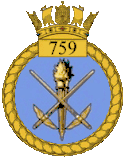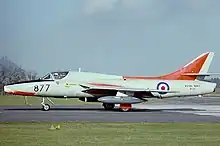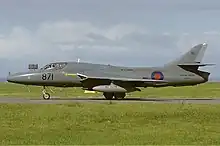| 759 Naval Air Squadron | |
|---|---|
 759 NAS badge | |
| Active | 1 May 1939 - 5 February 1946 16 August 1951 - 12 October 1954 1 August 1963 - 24 December 1969[1] |
| Country | |
| Branch | |
| Type | Fleet Air Arm Second Line Squadron |
| Role |
|
| Size | Squadron |
| Part of | Fleet Air Arm |
| Insignia | |
| Squadron Badge | Blue, in front of a torch inflamed two swords in saltire winged at the hilts all gold (1942)[2] |
| Identification Markings | single letters Y1A+ to Y7A+ later[3] 161-179 Seafire 180-183 Firebrand 210-215 Sea Fury 410-417 Meteor 451-456 Sea Hornet 180-182 Sea Vampire (1951) 220-240 Sea Vampire (1953) 655-664 to 800-811 Hunter[2] |

759 Naval Air Squadron (759 NAS) was a Naval Air Squadron of the Royal Navy's Fleet Air Arm. It was created on November 1, 1939, and was disbanded on December 24, 1969. It was initially intended as a Telegraphist Air Gunner Training Squadron but became a Fighter School and Pool Squadron in 1939, at RNAS Eastleigh (HMS Raven). It operated out of RNAS Yeovilton from 1940 to 1946, as part of the Naval Air Fighter School. In 1943 a detachment operated out of RNAS Angle (HMS Goldcrest), working with 794 NAS and known as the Naval Air Firing Unit.[2] It was again the Naval Air Fighter School upon reformation in 1951 and disbandment in 1954, firstly at RNAS Culdrose (HMS Seahawk) and then moving to RNAS Lossiemouth (HMS Fulmar), in 1953. The squadron reformed again, this time at RNAS Brawdy (HMS Goldcrest) in 1963, as the Naval Advanced Flying Training School, before finally disbanding in 1969.
History of 759 NAS
Fighter School and Pool Squadron (1939 - 1946)
759 Naval Air Squadron formed at RNAS Eastleigh (HMS Raven), in Hampshire, on 1 May 1939, intended as a Telegraphist Air Gunner Training Squadron, but renumbered as 758 Naval Air Squadron on the 1 July 1939. 759 NAS reformed as a Fighter School and Pool Squadron on the 1 November 1939, at Eastleigh. It was initially equipped with nine Skua, a carrier-based dive bomber / fighter aircraft, five Roc, another carrier-based fighter aircraft and four Sea Gladiator, a biplane fighter aircraft.[5] On the 1 December 1939, the squadron absorbed 769 Naval Air Squadron and became the Fleet Fighter School.[3]
Ten months later, on the 16 September 1940, the squadron relocated to RNAS Yeovilton (HMS Heron) near Yeovil, Somerset,[5] here it received Martlet, Fulmar and Master aircraft and in 1941 Sea Hurricane arrived. The squadron was the Advanced Flying School training, as part of the No.1 Naval Air Fighter School, from April 1943.[6] It had over sixty Sea Hurricane, over twenty Fulmar, fifteen Master and eight Spitfire aircraft at this point.[3] From the 1 July to the 22 November 1943, a detachment from 759 NAS operated out of RNAS Angle (HMS Goldcrest), in Pembrokeshire, utilsiing its Sea Hurricane and Fulmar aircraft.[7]
An instrument training flight, known as 'E' Flight, was formed the following year, in 1944.[3] The flight used Oxford aircraft and was operated as a sub-unit of 759 NAS.[2] Corsair, an American carrier-based fighter-bomber aircraft, were received later in 1944,[6] and this led to the creation of a conversion flight, designated 'A' flight, a camera air-to-air combat instruction flight, known as 'C' flight, and 'D' flight, for dummy deck landing training, however, these flights became 760 Naval Air Squadron in April 1945.[3] In September 1945, the squadron moved to RNAS Zeals (HMS Hummingbird), while Yeovilton's runways were repaired, returning to Yeovilton in January 1946.[2] 759 Naval Air Squadron disbanded at Yeovilton on the 5 February 1946.[8]
Naval Air Fighter School (1951 - 1954)
.jpg.webp)
759 Naval Air Squadron reformed at RNAS Culdrose (HMS Seahawk), near Helston on the Lizard Peninsula of Cornwall, on the 16 August 1951, out of a part of 738 NAS.[8] It was equipped with Firebrand, a British single-engine strike fighter and Seafire, a navalised carrier-capable version of the Supermarine Spitfire aircraft.
The following year a Jet Conversion Course was added to the training courses[6] and this pre-empted the squadron acquiring Sea Vampire and Meteor T.7 British jet fighter aircraft.
In November 1953, the squadron moved to RNAS Lossiemouth (HMS Fulmar),[9] located on the western edge of the town of Lossiemouth in Moray, north-east Scotland and remained there for just under twelve months, before disbanding there on the 12 October 1954,[8] into 736 Naval Air Squadron.[2]
Naval Advanced Flying Training School (1963 - 1969)

759 Naval Air Squadron reformed at RNAS Brawdy (HMS Goldcrest), located 6.3 miles (10.1 km) east of St Davids, Pembrokeshire, on the 1 August 1963,[8] as the Naval Advanced Flying Training School.[6] Here it was equipped with Hunter T.8 aircraft.[8] The squadron provided Part 1 of the Fleet Air Arm’s Advance Flying Training course.
In 1965, 759 NAS received the annual Boyd Trophy, which is awarded annually to the naval pilot(s) or aircrew who, in the opinion of the Flag Officer, Naval Air Command, has achieved the finest feat of aviation during the previous year, for its outstanding work in converting Jet Provost-trained pilots to the Hunter aircraft.[10]
On the 24 December 1969, 759 NAS disbanded at Brawdy.[8]
Aircraft flown
The squadron has flown a number of different aircraft types, including:[5][11]
- Blackburn Roc (Nov 1939 - Jun 1941)
- Blackburn Skua Mk.II (Nov 1939 - Jun 1941)
- Fairey Swordfish I (Nov 1939 - Jun 1941)
- Gloster Sea Gladiator (Nov 1939 - May 1943)
- de Havilland DH.60G Gypsy Moth (Jan 1940 - Mar 1943)
- Miles M.9B Master I (Feb 1940 - May 1944)
- Hawker Osprey I (Mar 1940 - Aug 1940)
- Percival P.28 Proctor IA (Mar 1940 - Feb 1943)
- Hawker Nimrod I (Apr 1940)
- de Havilland DH.87 Hornet Moth (May 1940 - Jun 1940)
- de Havilland DH.85 Leopard Moth (May 1940 - Jun 1940)
- Fairey Fulmar Mk.I (May 1940 - Jul 1943)
- Brewster Buffalo (Sep 1940 - Jul 1941)
- Grumman Martlet Mk I (Oct 1940 - May 1944)
- Miles M.18 (Jan 1941)
- Fairey Fulmar Mk.II (Feb 1941 - May 1943)
- Hawker Sea Hurricane Mk IB (May 1941 - Mar 1944)
- Hawker Hurricane Mk.I (Jun 1941 - Mar 1944)
- Percival P.30 Proctor II (Feb 1943)
- Hawker Sea Hurricane Mk IIC (Feb 1943 - Aug 1943)
- Fairey Swordfish II (May 1943)
- Supermarine Spitfire Mk Ia (May 1943 - Aug 1944)
- Supermarine Spitfire Mk Va (May 1943 - Oct 1944)
- Supermarine Spitfire Mk Vb (May 1943 - Oct 1944)
- Bristol Blenheim Mk.IV (Jul 1943 - Sep 1944)
- de Havilland DH.82 Tiger Moth (Jul 1943 - Feb 1944)
- Percival P.30 Proctor IIa (Aug 1943 - Dec 1943)
- Supermarine Spitfire Mk II (Aug 1943 - Oct 1943)
- Supermarine Seafire Mk Ib (Aug 1943 - Jan 1945)
- Miles M.19 Master II (Sep 1943 - Nov 1945)
- Bristol Blenheim Mk.I (Oct 1943)
- Grumman Martlet Mk IV (Nov 1943 - Jul 1945)
- Airspeed Oxford (Jan 1944 - Feb 1946)
- Supermarine Seafire F Mk IIc (Feb 1944 - Feb 1945)
- Vought Corsair Mk II (Mar 1944 - Apr 1944)
- Vought Corsair Mk III (Sep 1944 - Feb 1946)
- Grumman Wildcat Mk V (Oct 1944 - May 1945)
- North American Harvard III (Mar 1945 - Feb 1946)
- Vought Corsair Mk IV (Oct 1945 - Nov 1945)
- Supermarine Seafire F Mk III (Dec 1945 - Feb 1946)
- Grumman Hellcat F. Mk. II (Jan 1946)
- Supermarine Seafire F Mk XV (Jan 1946 - Feb 1946)
- de Havilland Sea Hornet F.20 (Aug 1951 - Feb 1953)
- de Havilland Sea Hornet PR.22 (Aug 1951 - Sep 1952)
- Blackburn Firebrand T.F. 5 (Aug 1951 - Feb 1953)
- Supermarine Seafire F Mk XVII (Aug 1951 - Jul 1954)
- de Havilland Sea Vampire
- Hawker Sea Fury T.20 (Feb 1952 - Jan 1954)
- de Havilland Vampire T.11 (Jul 1952 - Nov 1953)
- Supermarine Seafire F Mk 47 (Sep 1952 - Nov 1953)
- Gloster Meteor T.7 (Sep 1952 - Apr 1954)
- de Havilland Sea Vampire F.20 (Oct 1952 - Mar 1954)
- de Havilland Sea Vampire T.22 (Nov 1953 - Oct 1954)
- Hawker Hunter T.8 (Aug 1963 - Dec 1969)
Naval Air Stations
759 Naval Air Squadron operated from a number of naval air stations of the Royal Navy, in Wales, Scotland and England:
- Royal Naval Air Station EASTLEIGH (1 May 1939 - 1 July 1939)
- Royal Naval Air Station EASTLEIGH (1 November 1939 - 16 September 1940)
- Royal Naval Air Station YEOVILTON (16 September 1940 - 5 February 1946)
- Royal Naval Air Station CULDROSE (16 August 1951 - November 1953)
- Royal Naval Air Station LOSSIEMOUTH (November 1953 - 12 October 1954)
- Royal Naval Air Station BRAWDY (1 August 1963 - 24 December 1969)
Commanding Officers
List of commanding officers of 759 Naval Air Squadron with month and year of appointment:
1939 - 1946[3]
- Lieutenant Commander B.H.M. Kendall, RN, from November 1939
- Lieutenant Commander H.P. Bramwell, DSO, DSC, RN, from November 1940
- Captain F.D.G. Bird, RM, from August 1941
- Lieutenant Commander J.N. Garnett, RN, from October 1941
- Lieutenant Commander E.W.T. Taylour, DSC, RN, from December 1941
- -unknown- April 1942 - November 1942
- Lieutenant E.D.G. Lewin, DSO, DSC, RN, from November 1942
- Lieutenant Commander J.M. Bruen, DSO, DSC, RN, from December 1942
- Lieutenant Commander N.G. Hallett, DSC, RN, from May 1943
- Major F.D.G. Bird, RM, from December 1943
- Lieutenant Commander O.N. Bailey, RN, from July 1944
- Lieutenant Commander J.W. Sleigh, DSO, DSC, RN, from December 1944[11]
1951 - 1954
- Lieutenant Commander R. D. Lygo, RN (Aug 1951-May 1953)
- Lieutenant Commander D. R. O. Price, DFC, RN (May 1953-Jul 1954)
- Lieutenant Commander W. D. D. MacDonald, RN (Jul 1954-Oct 1954)
1963 - 1969
- Lieutenant Commander C.D.W. Pugh, MBE, RN, from August 1963
- Lieutenant Commander A.H. Milnes, RN, from January 1964
- Lieutenant Commander C.S. Casperd, RN, from March 1965
- Lieutenant Commander M.I. Darlington, RN, from October 1966
- Lieutenant Commander C.C.N. Davis, RN, from June 1968
759E Flight[11]
Notes
- ↑ Sturtivant & Ballance 1994, p. 77.
- 1 2 3 4 5 6 Ballance 2016, p. 60.
- 1 2 3 4 5 6 Wragg 2019, p. 126.
- ↑ "WT702 FRADU". www.fradu.info. Retrieved 23 March 2023.
- ↑ "The_Fulmar_Story1st_ed" (PDF). www.faaba.co.uk. Retrieved 18 December 2022.
- ↑ Sturtivant & Ballance 1994, p. 383.
- 1 2 3 Ballance 2016, p. 61.
References
- Sturtivant, R; Ballance, T (1994). The Squadrons of The Fleet Air Arm. Tonbridge, Kent, UK: Air-Britain (Historians) Ltd. ISBN 0-85130-223-8.
- Wragg, David (2019). The Fleet Air Arm Handbook 1939-1945. Cheltenham, Gloucestershire, UK: The History Press. ISBN 978-0-7509-9303-6.
- Ballance, Theo (2016). The Squadrons and Units of the Fleet Air Arm. Air-Britain. ISBN 978-0-85130-489-2.